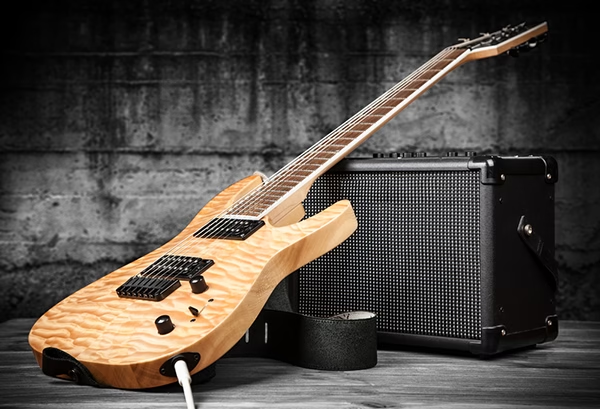1. Understanding Guitar Strings and Their Impact
Few components shape your guitar’s character as profoundly as its guitar strings. Whether you’re a beginner or a professional musician, understanding what makes them unique can elevate your sound instantly. The right strings affect tone, feel, sustain, and tuning stability, while the wrong ones can make even the best guitar sound lifeless.
Every vibration from your guitar strings travels through the bridge and pickups, defining how your amp, effects, and technique combine into your signature tone. As guitar legend B.B. King once said, “The magic’s in the strings.”
There are three main categories: acoustic, electric, and classical. Each uses different materials and tension levels, which we’ll explore below.
2. The Science Behind String Materials and Tone
Different materials dramatically affect your guitar strings’ sound and feel:
-
Nickel-plated steel (electric guitars) – Offers a balanced tone between warmth and brightness.
-
Pure nickel – Produces a vintage, mellow tone, perfect for blues and classic rock.
-
Stainless steel – Brighter and longer-lasting but can feel harsher on fingers.
-
Bronze and phosphor bronze (acoustic guitars) – Deliver rich harmonics and articulate projection.
-
Nylon (classical guitars) – Soft and expressive, ideal for fingerstyle and flamenco.
Research from D’Addario Strings notes that metal alloys influence not only frequency response but also sustain and corrosion resistance (source).
Selecting the right material depends on your style, genre, and playing dynamics. A jazz guitarist may favor warm nickel tones, while a metal player thrives on the crisp bite of stainless steel.
3. Gauge, Tension, and Playability Explained
When players talk about “light” or “heavy” strings, they’re referring to gauge — the diameter measured in thousandths of an inch (e.g., .010, .046).
-
Light gauge strings (like .009–.042) are easier to bend and ideal for lead playing or beginners.
-
Heavy gauge strings (like .011–.052) provide more tension and fuller tone, great for drop tunings or rhythm-heavy styles.
Tension influences both comfort and tone. Heavier guitar strings can make a guitar sound louder and sustain longer, but they demand stronger fretting and can strain your neck if not adjusted properly.
A 2023 study in Applied Acoustics showed that even minor changes in string tension can alter harmonic overtones by up to 12%, affecting perceived warmth (source).
4. Coated vs. Uncoated Strings: The Durability Debate
Today’s players face a crucial choice: coated or uncoated guitar strings.
-
Uncoated strings provide pure, bright tone but corrode faster from sweat and air exposure.
-
Coated strings have a micro-polymer layer that resists grime and moisture, extending life by 2–3x.
Brands like Elixir, Ernie Ball Paradigm, and D’Addario XS pioneered coatings that maintain tone while adding protection. Though coated strings cost more, they can save time and money in the long run.
For touring musicians or humid environments, coated guitar strings are invaluable. However, studio players may prefer the unfiltered brilliance of uncoated ones.
5. String Maintenance: The Overlooked Secret Weapon
Your guitar strings are only as good as the care they receive. Many tone issues blamed on pickups or amps actually stem from neglected strings.
Here’s a quick maintenance routine:
-
Wipe down strings after every session with a microfiber cloth.
-
Use a cleaner like GHS Fast-Fret to remove oils.
-
Change strings every 1–3 months (or after 30 hours of play).
-
Store guitars in stable humidity (40–50%) to prevent rust and neck warp.
Pro tip: when restringing, stretch your guitar strings gently to help them settle faster and hold tuning stability.
According to a Fender research blog, players who change strings regularly report 25% fewer tuning problems and more consistent intonation (source).
6. Choosing the Right Brand and Setup
The market is packed with guitar string brands, each offering a unique tonal identity:
-
Ernie Ball – Bright, punchy, and versatile (favored by Slash and Clapton).
-
D’Addario – Reliable, balanced tone, used by countless professionals.
-
Elixir – Long-lasting coated design ideal for touring artists.
-
Martin – Warm and resonant for acoustic players.
-
La Bella / Savarez – Top picks for classical and nylon-string guitars.
Experimenting across brands helps discover your personal feel and tone signature. Keep notes on guitar strings you’ve tried, gauging comfort, tone, and tuning stability.
Pair the right strings with proper setup — correct truss rod tension, nut slot depth, and bridge height — to maximize playability.
7. When to Replace and How to Upgrade Your Tone
Even the best guitar strings have a lifespan. Over time, oils and corrosion dampen resonance, intonation, and brightness. Signs it’s time to replace:
-
Darkened or rough texture
-
Dull tone despite cleaning
-
Difficulty staying in tune
-
Uneven volume between strings
To upgrade your tone:
-
Try hybrid sets (light top, heavy bottom) for versatility.
-
Switch to flatwound strings for jazz or recording clarity.
-
Experiment with half-rounds for balanced playability.
Changing guitar strings is one of the most affordable tone upgrades — a $10 investment can make your instrument sound brand new.
As the saying goes among professionals: “New strings, new inspiration.”
Conclusion: The Soul of Every Guitar
Whether acoustic or electric, guitar strings are the true soul of your instrument. They translate emotion into sound, vibration into melody, and touch into art. By understanding how gauge, material, and maintenance influence tone, you can unlock expressive control and consistency few players ever master.
So the next time your playing feels uninspired, remember — the answer may not be new gear, but simply a fresh set of guitar strings tuned perfectly to your touch and tone.







